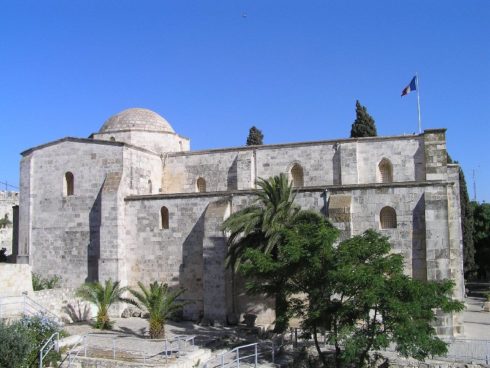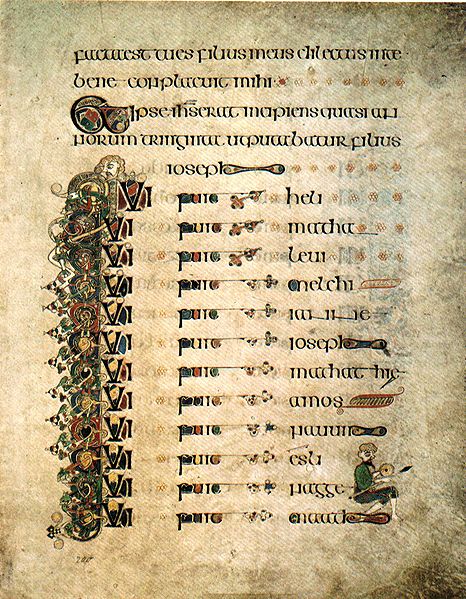Mary’s Davidic ancestry
St. Luke (2:4) says that St. Joseph went from Nazareth to Bethlehem to be enrolled, “because he was of the house and family of David”. As if to exclude all doubt concerning the Davidic descent of Mary, the Evangelist (1:32, 69) states that the child born of Mary without the intervention of man shall be given “the throne of David His father”, and that the Lord God has “raised up a horn of salvation to us in the house of David his servant”. [1] St. Paul too testifies that Jesus Christ “was made to him [God] of the seed of David, according to the flesh” (Romans 1:3). If Mary were not of Davidic descent, her Son conceived by the Holy Ghost could not be said to be “of the seed of David”. Hence commentators tell us that in the text “in the sixth month the angel Gabriel was sent from God. . .to a virgin espoused to a man whose name was Joseph, of the house of David” (Luke 1:26-27); the last clause “of the house of David” does not refer to Joseph, but to the virgin who is the principal person in the narrative; thus we have a direct inspired testimony to Mary’s Davidic descent. [2]

Rose window in Basilica of St Denis, France, depicting the ancestors of Our Lord from Jesse onwards.
While commentators generally agree that the genealogy found at the beginning of the first Gospel is that of St. Joseph, Annius of Viterbo proposes the opinion, already alluded to by St. Augustine, that St. Luke’s genealogy gives the pedigree of Mary. The text of the third Gospel (3:23) may be explained so as to make Heli the father of Mary: “Jesus. . .being the son (as it was supposed of Joseph) of Heli”, or “Jesus. . .being the son of Joseph, as it was supposed, the son of Heli” (Lightfoot, Bengel, etc.), or again “Jesus. . .being as it was supposed the son of Joseph, who was [the son-in-law] of Heli” [3]. In these explanations the name of Mary is not mentioned explicitly, but it is implied; for Jesus is the Son of Heli through Mary.
Her parents
Though few commentators adhere to this view of St. Luke’s genealogy, the name of Mary’s father, Heli, agrees with the name given to Our Lady’s father in a tradition founded upon the report of the Protoevangelium of James, an apocryphal Gospel which dates from the end of the second century. According to this document the parents of Mary are Joachim and Anna. Now, the name Joachim is only a variation of Heli or Eliachim, substituting one Divine name (Yahweh) for the other (Eli, Elohim). The tradition as to the parents of Mary, found in the Gospel of James, is reproduced by St. John Damascene [4], St. Gregory of Nyssa [5], St. Germanus of Constantinople [6], pseudo-Epiphanius [7], pseudo-Hilarius [8], and St. Fulbert of Chartres [9]. Some of these writers add that the birth of Mary was obtained by the fervent prayers of Joachim and Anna in their advanced age. As Joachim belonged to the royal family of David, so Anna is supposed to have been a descendant of the priestly family of Aaron; thus Christ the Eternal King and Priest sprang from both a royal and priestly family [10].

Mary’s Well (or “The spring of the Virgin Mary”) was the city’s main source of water in Nazareth. Some believe that this is where Mary used to bathe Jesus and wash His clothes and that Our Lord would come to fetch water for Our Lady.
The hometown of Mary’s parents
According to Luke 1:26, Mary lived in Nazareth, a city in Galilee, at the time of the Annunciation. A certain tradition maintains that she was conceived and born in the same house in which the Word became flesh [11]. Another tradition based on the Gospel of James regards Sephoris as the earliest home of Joachim and Anna, though they are said to have lived later on in Jerusalem, in a house called by St. Sophronius of Jerusalem [12] Probatica. Probatica, a name probably derived from the sanctuary’s nearness to the pond called Probatica or in John 5:2. It was here that Mary was born. About a century later, about A.D. 750, St. John Damascene [13] repeats the statement that Mary was born in the Probatica.

Church of St Anne in Jerusalem. The church is dedicated to St. Anne and St. Joachim, who according to tradition lived here, and the site where Our Lady was born, in a cave which is located under the basilica. A section of the basilica is over the Pool of Bethesda.
It is said that, as early as in the fifth century the empress Eudoxia built a church over the place where Mary was born, and where her parents lived in their old age. The present Church of St. Anna stands at a distance of only about 100 Feet from the pool Probatica. In 1889, 18 March, was discovered the crypt which encloses the supposed burying-place of St. Anna. Probably this place was originally a garden in which both Joachim and Anna were laid to rest. At their time it was still outside of the city walls, about 400 feet north of the Temple. Another crypt near St. Anna’s tomb is the supposed birthplace of the Blessed Virgin; hence it is that in early times the church was called St. Mary of the Nativity [14]. In the Cedron Valley, near the road leading to the Church of the Assumption, is a little sanctuary containing two altars which are said to stand over the burying-places of Sts. Joachim and Anna; but these graves belong to the time of the Crusades [15]. In Sephoris too the Crusaders replaced by a large church an ancient sanctuary which stood over the legendary house of Sts. Joachim and Anna. After 1788 part of this church was restored by the Franciscan Fathers.
[1] cf. Tertullian, de carne Christi, 22; P.L., II, 789; St. Aug., de cons. Evang., II, 2, 4; P.L., XXXIV, 1072.
[2] Cf. St. Ignat., ad Ephes, 187; St. Justin, c. Taryph., 100; St. Aug., c. Faust, xxiii, 5-9; Bardenhewer, Maria Verkundigung, Freiburg, 1896, 74-82; Friedrich, Die Mariologie des hl. Augustinus, Cöln, 1907, 19 sqq.
[3] Jans., Hardin., etc.
[4] hom. I. de nativ. B.V., 2, P.G., XCVI, 664
[5] P.G., XLVII, 1137
[6] de praesent., 2, P.G., XCVIII, 313
[7] de laud. Deipar., P.G., XLIII, 488
[8] P.L., XCVI, 278
[9] in Nativit. Deipar., P.L., CLI, 324
[10] cf. Aug., Consens. Evang., l. II, c. 2
[11] Schuster and Holzammer, Handbuch zur biblischen Geschichte, Freiburg, 1910, II, 87, note 6
[12] Anacreont., XX, 81-94, P.G., LXXXVII, 3822
[13] hom. I in Nativ. B.M.V., 6, II, P.G., CCXVI, 670, 678
[14] cf. Guérin, Jérusalem, Paris, 1889, pp. 284, 351-357, 430; Socin-Benzinger, Palästina und Syrien, Leipzig, 1891, p. 80; Revue biblique, 1893, pp. 245 sqq.; 1904, pp. 228 sqq.; Gariador, Les Bénédictins, I, Abbaye de Ste-Anne, V, 1908, 49 sq.
[15] cf. de Vogue, Les églises de la Terre-Sainte, Paris, 1850, p. 310
(cfr. Catholic Encyclopedia)











